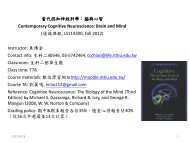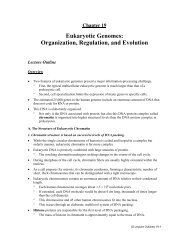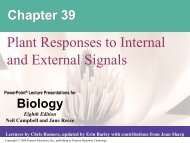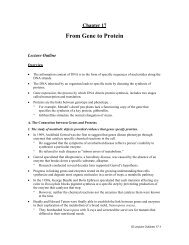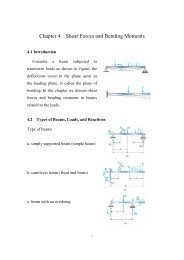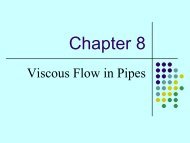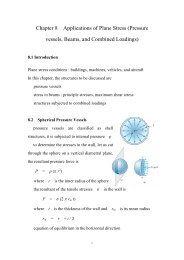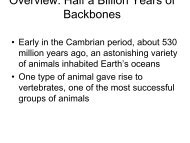8.4 The Natural Response of a Series/Parallel RLC Circuit
8.4 The Natural Response of a Series/Parallel RLC Circuit
8.4 The Natural Response of a Series/Parallel RLC Circuit
- No tags were found...
Create successful ePaper yourself
Turn your PDF publications into a flip-book with our unique Google optimized e-Paper software.
8.1 Linear Second Order <strong>Circuit</strong>s• <strong>Circuit</strong>s containing two energy storage elements.• Described by differential equations that containsecond order derivatives.• Need two initial conditions to get the uniquesolution.C.T. Pan 38.1 Linear Second Order <strong>Circuit</strong>s• Examples(a) <strong>RLC</strong> parallel circuit(b) <strong>RLC</strong> series circuitis() t+vt ()−vs() tit ()C.T. Pan 4
8.1 Linear Second Order <strong>Circuit</strong>s(c) 2L+R , RL circuitR1R2vs() tL L12(d) 2C+R , RC circuitRis() tC 1C 2C.T. Pan 58.2 Solution StepsStep1 : Choose nodal analysis or meshanalysis approachStep2 : Differentiate the equation as manytimes as required to get the standardform <strong>of</strong> a second order differentialequation .2d x dxa + b + x=yt ()2dt dtC.T. Pan 6
8.3 Finding Initial ValuesUnder transient condition, L is like an open circuitand C is like a short circuit because i L (t) ) and v C (t)are continuous functions if the input is bounded.C.T. Pan 98.3 Finding Initial ValuesUnder transient condition, L is like an open circuitand C is like a short circuit because i L (t) ) and v C (t)are continuous functions if the input is bounded.C.T. Pan 10
8.3 Finding Initial Values• Example 1 (cont.)t < 0∴ i(0 + ) = i(0 - ) = 2 Av(0 + ) = v(0 - ) = 4 Vi(0 - ) = 2 Av(0 - ) = 4 VC.T. Pan 138.3 Finding Initial Values• Example 1 (cont.)t = 0 ++di d + VL(0 )Q L = VL, ∴ i(0 ) =dt dt L+dv d + iC(0 )QC= iC, ∴ v(0 ) =dt dt CC.T. Pan 14
8.3 Finding Initial Values• Example 1 (cont.)+KVL: 2A× 4 + v (0 ) + 4V = 12V+∴ v (0 ) = 0d i+∴ (0 ) = 0dt+KCL: i (0 ) = 2ACLLd v+∴ (0 ) = 0dt+iC(0 ) 2∴ = = 20 V/SC 0.1C.T. Pan 158.3 Finding Initial Values• Example 1 (cont.)4Ω 0.25Hi2Ω12V0.1F + v-t=0t →∞L is short circuitdC is open∴i( ∞ ) = 0v( ∞ ) = 12VC.T. Pan 16
• Example 28.3 Finding Initial Values4Ω3u(t)A 2Ω__ 12 F ++ vcv R --0.6H20Vi L+ d +Find : ( a) iL(0 ) , iL(0 ) , iL( ∞)dt+ d +( b) vC(0 ) , vC(0 ) , vC( ∞)dt+ d +() c vR(0 ) , vR(0 ) , vR( ∞)dtC.T. Pan 178.3 Finding Initial Values• Example 2 (cont.)4Ω3u(t)A 2Ω1__2 F ++ vcv R --0.6H20Vi Lt < 02Ω+v R-4Ω20V+v c-i L−∴ i (0 ) = 0L−v (0 ) =−20VvcR−(0 ) = 0C.T. Pan 18
8.3 Finding Initial Values• Example 2 (cont.)4Ω3u(t)A 2Ω__ 12 F ++ vcv R --0.6H20Vi L t = 0 ++ −∴ i (0 ) = i (0 ) = 0LL+ −v (0 ) = v (0 ) =−20VccC.T. Pan 198.3 Finding Initial Values• Example 2 (cont.)4Ω3u(t)A 2Ω__ 12 F ++ vcv R --0.6H20V3A2Ωt = 0 ++ v o (0 + ) -4Ω+v R (0 + )-i c (0 + )i L+ 4i2Ω(0 ) = 3A× = 2A2+4+vR(0 ) = 2A× 2=4V+ 2ic(0 ) = 3A× = 1A2+4+d vL(0 ) 0i+∴L(0 ) = = = 0dt L L+d + ic(0 ) 1vc(0 ) = = = 2dt c 1 2d v+R(0 ) = ?dtC.T. Pan 20VS
8.3 Finding Initial Values• Example 2 (cont.)4Ω3u(t)A 2Ω__ 12 F ++ vcv R --0.6H20Vi L t > 0 +3A2Ω+ v o -4Ω1__ + i L+ 2 F vcv R-- 0.6H20VFrom KVL: − v + v + v + 20=0R o cTake derivatived d dvR() t = vo() t + vc()tdt dt dtd + d + d +∴ vR(0 ) = vo(0 ) + vc(0 ) LL( A)dt dt dtC.T. Pan 218.3 Finding Initial Values• Example 2 (cont.)4Ω3u(t)A 2Ω__ 12 F ++ vcv R --0.6H20Vi L t > 0 +3A2Ω+ v o -4Ω1__ + i L+ 2 F vcv R-- 0.6H20VvR()t vo()tAlso , from KCL: 3A= +2 4Take derivative1 d 1 d0 = vR() t + vo() t LL(B)2 dt 4 dtC.T. Pan 22
8.3 Finding Initial Values• Example 2 (cont.)d + d +From ( B) vo(0 ) =−2 vR(0 ) LL( C)dt dtFrom ( A) and ( C)d + d +vR(0 ) =− 2 vR(0 ) + 2dtdtd 2 v+∴ (0 ) VR=dt 3 SC.T. Pan 238.3 Finding Initial Values• Example 2 (cont.)4Ω3u(t)A 2Ω__ 12 F ++ vcv R --0.6H20Vi Lt →∞3A2Ω4Ω+v R ( )-+v c ( )-20Vi L2∴iL( ∞ ) = 3A× = 1A2+4v ( ∞ ) =−20Vcv ( ∞ ) = 3 A× (2ΩP4 Ω ) = 4VRC.T. Pan 24
<strong>8.4</strong> <strong>The</strong> <strong>Natural</strong> <strong>Response</strong> <strong>of</strong> a <strong>Series</strong>/<strong>Parallel</strong><strong>RLC</strong> <strong>Circuit</strong>(a) <strong>The</strong> source-free series <strong>RLC</strong> circuitThis section is an important background for studyingfilter design and communication networks .initial conditions⎧i(0)= I0⎨⎩v(0)= V0C.T. Pan 25<strong>8.4</strong> <strong>The</strong> <strong>Natural</strong> <strong>Response</strong> <strong>of</strong> a <strong>Series</strong>/<strong>Parallel</strong><strong>RLC</strong> <strong>Circuit</strong>initial conditions⎧i(0)= I0⎨⎩v(0)= V0Step 1 : Mesh analysisdi 1 tRi+ L + idt 0dt C∫=−∞To eliminate the integral , take derivative2di di 12dt dt CL + R + i = 0C.T. Pan 26
<strong>8.4</strong> <strong>The</strong> <strong>Natural</strong> <strong>Response</strong> <strong>of</strong> a <strong>Series</strong>/<strong>Parallel</strong><strong>RLC</strong> <strong>Circuit</strong>initial conditions⎧i(0)= I0⎨⎩v(0)= V0Step 2 : Homogeneous solution , characteristic equation2 R 1S + S+ =0L LC2 2 R 2 1S +2αS+ω0=0 ⇒ α @ , ω0@2L LCω : undamped resonant frequency (rad/s)0α : damping factor or neper frequencyC.T. Pan 27<strong>8.4</strong> <strong>The</strong> <strong>Natural</strong> <strong>Response</strong> <strong>of</strong> a <strong>Series</strong>/<strong>Parallel</strong><strong>RLC</strong> <strong>Circuit</strong>initial conditions⎧i(0)= I0⎨⎩v(0)= V0characteristic roots (natural frequencies)S =-α+ α -ω2 21 0S =-α- α -ω2 22 0St 1 St 2() 1 2∴ i t = Ae + Ae+ d +Need two initial conditions , i.e. , i(0 ) and i(0 ) .diC.T. Pan 28
<strong>8.4</strong> <strong>The</strong> <strong>Natural</strong> <strong>Response</strong> <strong>of</strong> a <strong>Series</strong>/<strong>Parallel</strong><strong>RLC</strong> <strong>Circuit</strong>Case 1 Overdamped Case ( α > ω )Two real rootsSt 1 St 2() =1+2i t Ae AeCase 2 Critically Damping Case ( α= ω )Equal real rootsRS1 = S2=− =−α2Li t = A + At e −αt() ( )2 100C.T. Pan 29<strong>8.4</strong> <strong>The</strong> <strong>Natural</strong> <strong>Response</strong> <strong>of</strong> a <strong>Series</strong>/<strong>Parallel</strong><strong>RLC</strong> <strong>Circuit</strong>Case 3 Underdamped Case ( α < ω )Complex conjugate rootsSS12=− α + jω()dd=−α− jωω @ ω −αd2 20−αti t = e B cosωt+B sinω1 d 20damping frequency( )Once i(t) is obtained ,solutions <strong>of</strong> other variables can beobtained from this mesh current.dtC.T. Pan 30
<strong>8.4</strong> <strong>The</strong> <strong>Natural</strong> <strong>Response</strong> <strong>of</strong> a <strong>Series</strong>/<strong>Parallel</strong><strong>RLC</strong> <strong>Circuit</strong>• <strong>The</strong> damping effect is due to the presence <strong>of</strong> resistance R .• <strong>The</strong> damping factor α determines the rate at which theresponse is damped .• If R=0 , the circuit is said to be lossless and theoscillatory response will continue .• <strong>The</strong> damped oscillation exhibited by the underdampedresponse is known as ringing . It stems from the ability <strong>of</strong>the L and C to transfer energy back and forth betweenthem .C.T. Pan 31<strong>8.4</strong> <strong>The</strong> <strong>Natural</strong> <strong>Response</strong> <strong>of</strong> a <strong>Series</strong>/<strong>Parallel</strong><strong>RLC</strong> <strong>Circuit</strong>Step 3 : Initial Condition+ + −t = 0, i(0 ) = i(0 ) = IFrom mesh equation , let t = 0+1 0+ d +Ri(0 ) + L i(0 ) + idt 0dt C∫=−∞d + R + V0R∴ i(0 ) =− i(0 ) − =− Idt L L L0+0V0−LC.T. Pan 32
<strong>8.4</strong> <strong>The</strong> <strong>Natural</strong> <strong>Response</strong> <strong>of</strong> a <strong>Series</strong>/<strong>Parallel</strong><strong>RLC</strong> <strong>Circuit</strong>or from equivalent circuit at t=0d +L i(0 ) = vL=− ( IR0+ V0)dtd IR0Vi+0∴ (0 ) =− −dt L L+RI 0v LV 0iC.T. Pan 33<strong>8.4</strong> <strong>The</strong> <strong>Natural</strong> <strong>Response</strong> <strong>of</strong> a <strong>Series</strong>/<strong>Parallel</strong><strong>RLC</strong> <strong>Circuit</strong>(b) <strong>The</strong> source-free parallel <strong>RLC</strong> circuitinitial inductor current I oinitial capacitor voltage V oStep 1 : Nodal Equationv 1 t dv+ vdt C 0R L∫+ =dtTaking derivative to eliminate the integral2dv 1 dv 1+ + v = 02dt RC dt LCC.T. Pan 34
<strong>8.4</strong> <strong>The</strong> <strong>Natural</strong> <strong>Response</strong> <strong>of</strong> a <strong>Series</strong>/<strong>Parallel</strong><strong>RLC</strong> <strong>Circuit</strong>Step 2 : Homogeneous solutionCharacteristic equation2 1 1S + S+ = 0RC LC2 2 1 2 1S + 2αS+ ω0 = 0 ⇒ α @ , ω0@2RCLCcharacteristic roots ( naturalfrequencies)SS=− α + α −ω2 21 0=−α − α −ω2 22 0C.T. Pan 35<strong>8.4</strong> <strong>The</strong> <strong>Natural</strong> <strong>Response</strong> <strong>of</strong> a <strong>Series</strong>/<strong>Parallel</strong><strong>RLC</strong> <strong>Circuit</strong>CASE 1. Overdamped Case (α>w(>w 0 )St 1 2( ) = +v t Ae Ae1 2CASE 2. Critically Damped Case (α=w(0 )( ) = ( + )1 2CASE 3. Underdamped Case (α
<strong>8.4</strong> <strong>The</strong> <strong>Natural</strong> <strong>Response</strong> <strong>of</strong> a <strong>Series</strong>/<strong>Parallel</strong><strong>RLC</strong> <strong>Circuit</strong>Step 3 : Initial Condition+ −v(0 ) = i(0 ) = VFrom nodal equation+( )+( )C.T. Pan 370v 0+1 0 d ++ vdt C v( 0 ) 0R L∫+ =−∞dtv 0+d1 0+∴ C v( 0 ) =− − vdtdt R L∫−∞V0=− −I0Rd V0 Iv+0∴ ( 0 ) =− −dt RC C<strong>8.4</strong> <strong>The</strong> <strong>Natural</strong> <strong>Response</strong> <strong>of</strong> a <strong>Series</strong>/<strong>Parallel</strong><strong>RLC</strong> <strong>Circuit</strong>or from equivalent circuit at t=0d + +C v(0 ) = iC( 0 )dt+d iC(0 )v+∴ (0 ) =dt C+ V0From KCL, iC(0 ) =−I0−ROnce the nodal voltage is obtained, any other unknown<strong>of</strong> the circuit can be found .+C.T. Pan 38
8.5 <strong>The</strong> Step <strong>Response</strong> <strong>of</strong> a <strong>Series</strong>/<strong>Parallel</strong> <strong>RLC</strong><strong>Circuit</strong>(a) Step response <strong>of</strong> a series<strong>RLC</strong> circuitStep 1. Mesh analysis (i=i L )di 1L + Ri+ idt = Vs, t > 0dt C∫Case(i) take derivatived 2i + Rdi + i = 02Ldt dt CC.T. PanSame as natural response but with i(0 + )=I 0+ Vs−IR 0−V0( 0 ) =39d idtL8.5 <strong>The</strong> Step <strong>Response</strong> <strong>of</strong> a <strong>Series</strong>/<strong>Parallel</strong> <strong>RLC</strong><strong>Circuit</strong>Case(ii) use v as unknowndvi = C dt2dv Rdv v V+ + = s2dt Ldt LC LCStep 2. Complete solution = v h +v pph( )v t = VsSt 1 St 2⎧ Ae1+ Ae2overdamped⎪v t A At e critically damped−αt() = ⎨( 1+2 )⎪ −αt( cos + sin )⎩e A1 wtdA2wtdunderdampedC.T. Pan 40
8.5 <strong>The</strong> Step <strong>Response</strong> <strong>of</strong> a <strong>Series</strong>/<strong>Parallel</strong> <strong>RLC</strong><strong>Circuit</strong>Step 3. Initial conditions+ −( 0 ) ( 0 )v = v = Vd vdtdvC+( )0 = ?= idtC0+( 0 ) I0d iCv+∴ ( 0 ) = =dt C C<strong>The</strong>n the unique solution can be determinedC.T. Pan 418.5 <strong>The</strong> Step <strong>Response</strong> <strong>of</strong> a <strong>Series</strong>/<strong>Parallel</strong> <strong>RLC</strong><strong>Circuit</strong>(b) Step response <strong>of</strong> a parallel <strong>RLC</strong> circuitI 0 , V 0 GivenStep 1.Nodal equationv 1 t dv+ vdt C Is, t 0R L∫+ = >dtCase (i) Take derivativeC2dv 1 dv 12dt Rdt L+ + v=0Same as natural responseC.T. Pan 42
8.5 <strong>The</strong> Step <strong>Response</strong> <strong>of</strong> a <strong>Series</strong>/<strong>Parallel</strong> <strong>RLC</strong><strong>Circuit</strong>Case (ii) Let2di di 1 di 1 I s2dt dt RC dt LC LCv= L ⇒ + + i = , t > 0Step 2. Complete solution = i h (t)+i p (t)Step 3.ph( )i t = IsSt 1 St 2⎧ Ae1+ Ae2overdamped⎪i t A At e critically damped−αt() = ⎨( 1+2 )⎪ −αt( cos + sin )⎩e A1 wtdA2wtdundererdampedInitial Condition+ −( 0 ) ( 0 )i = i = I0di d vL ( 0)(0)+Vdt dt L L+0C.T. Pan L = vL⇒ i = =438.5 <strong>The</strong> Step <strong>Response</strong> <strong>of</strong> a <strong>Series</strong>/<strong>Parallel</strong> <strong>RLC</strong><strong>Circuit</strong>• Example1 F2- -t < 0 , i(0 )=0 , v(0 ) =12Vt>01 F2C.T. Pan44
8.5 <strong>The</strong> Step <strong>Response</strong> <strong>of</strong> a <strong>Series</strong>/<strong>Parallel</strong> <strong>RLC</strong><strong>Circuit</strong>C.T. PanMethod (a)v 1 dvFrom KCL ⇒ i = +2 2 dt(A)diFrom KVL ⇒ 4i+ 1 + v = 12dt(B)Substitute (A) into (B)2dv 1 dv 1 d v(2v+ 2 )+( + )+ v= 122dt 2 dt 2 dt2⇒ d v dv5 6v24V2dt+ dt+ =Characteristic equation( s+ 2)( s+ 3) = 0s=− 2, s =−31 2458.5 <strong>The</strong> Step <strong>Response</strong> <strong>of</strong> a <strong>Series</strong>/<strong>Parallel</strong> <strong>RLC</strong><strong>Circuit</strong>v () t = A e + A eh−2t−3t1 224vp() t = = 4V6∴ vt () = 4+ A e + A e−2t−3t1 2+ -Initial Condition v(0 )= v(0 )=12V+t=01 F2C.T. PandvC = icdt++dv(0 ) ic(0 ) −646∴ = = =−12 V/Sdt C 1/2
8.5 <strong>The</strong> Step <strong>Response</strong> <strong>of</strong> a <strong>Series</strong>/<strong>Parallel</strong> <strong>RLC</strong><strong>Circuit</strong>∴ 4+ A + A = 121 2−2A − 3A =−121 2∴ A = 12, A =−41 2∴ vt = + e − e t ≥2 3() 4 12 − t − t4 , 0Method (b) Using Mesh Analysist>04Ωi1HC.T. Pan12V2Ω1i 1 i 2v F2478.5 <strong>The</strong> Step <strong>Response</strong> <strong>of</strong> a <strong>Series</strong>/<strong>Parallel</strong> <strong>RLC</strong><strong>Circuit</strong>di1 + 4 i+ ( i1− i2)2=12 ......(A)dt1 t( i2 − i1) × 2Ω+ 20 ......(B)1/2∫idt =di2 di1From (B) , 2 − 2 + 2i2= 0dt dtdi+ 6i1− 2i2= 12dtdi1 di2− 2 + 2 + 2i2= 0dt dt1 F2C.T. Pan48
8.5 <strong>The</strong> Step <strong>Response</strong> <strong>of</strong> a <strong>Series</strong>/<strong>Parallel</strong> <strong>RLC</strong><strong>Circuit</strong>dIn matrix form with operator D@dt⎡D+ 6 −2 ⎤⎡i1⎤ ⎡12⎤⎢ =− 2D2D+2⎥⎢ i⎥ ⎢20⎥⎣ ⎦⎣ ⎦ ⎣ ⎦(C)C.T. Pan+ + −Initial Condition , i (0 ) = i(0 ) = i(0 ) = 0A+ +i (0 ) = i (0 ) =−6A2c+ +di1(0 ) vL(0 )= = 0dt L+di2(0 )= 0 A/Sdt1498.5 <strong>The</strong> Step <strong>Response</strong> <strong>of</strong> a <strong>Series</strong>/<strong>Parallel</strong> <strong>RLC</strong><strong>Circuit</strong>Eliminate ivariable from (C)2di1 di1+ 5 + 6i21= 12dt dt∴ i t = − e + e t ≥−2t−3t1() 2 6 4 , 0Or eliminate i2variable from (C)2di2 di2+ 5 + 6i22= 0dt dt∴ i t =− e + e t ≥1−2t−3t2() 12 6 , 0C.T. Pan50
8.5 <strong>The</strong> Step <strong>Response</strong> <strong>of</strong> a <strong>Series</strong>/<strong>Parallel</strong> <strong>RLC</strong><strong>Circuit</strong>Problem : (a) Time consuming to eliminate the othervariable to get a higher order differentialequation.(b) It is also necessary to obtain the desiredinitial conditions.(c) As the order gets higher when thenetwork contains more energy storageelements, the process gets morecomplicated.<strong>The</strong> difficulty can be overcome by using state equationformulation.C.T. Pan518.6 State EquationWhen the differential equations <strong>of</strong> a circuit is written inthe following form:d x = f ( xut , ,)dtTx = [ x x .... x ] state vectorT1 2u = [ u u .... u ] input vector1 2Tf = [ f f .. f ] vector function1 2nnmC.T. Pan52
8.6 State EquationIt is said that the circuit equations are in the stateequation form.(a) This form lends itself most easily to analog or digitalcomputer programming.(b) <strong>The</strong> extension to nonlinear and/or time varyingnetworks is quite easy.(c) In this form, a number <strong>of</strong> theoretic concepts <strong>of</strong>systems are readily applicable to networks.C.T. Pan 53For a linear time-invarying circuit , a simpler formd x = A x + B u , state equationdty= Cx+D u , output equationA : n×n matrix.B : n×m matrix.C :8.6 State Equationl×n matrix.D: l × m matrix.Note that on the right hand side <strong>of</strong> the state or outputequation, only x and u are allowed.C.T. Pan54
8.6 State EquationStep1. Pick a tree which contains all the capacitors andnone <strong>of</strong> inductors.Step2. Use the tree-branch capacitor voltages and thelink inductor currents as unknown (i.e. , state)variables.Note: (a) Nodal AnalysisEvery unknown <strong>of</strong> the circuit can becalculated from nodal voltages.(b) Mesh AnalysisEvery unknown <strong>of</strong> the circuit can becalculated from mesh currents.C.T. Pan558.6 State Equation(c) State Equation• <strong>The</strong> chosen variables include bothvoltage and current unknown. It belongsto mixed type.• Every unknown <strong>of</strong> the circuit can becalculated from the state variables byreplacing each inductor with a currentsource and each capacitor with a voltagesource and then solving the resultingresistive circuit.C.T. Pan56
8.6 State EquationStep3. Write a fundamental cutset equation (i.e. KCLequation) for each capacitor.Note that in these cutsetequations, all branchcurrents must be expressed in terms <strong>of</strong> x and u.Step4. Write a fundamental loop equation (i.e. KVLequation) for each inductor.Note that in these loop equations, all branchvoltages must be expressed in terms <strong>of</strong> x and u.Step5. Rearrange the above equations into standard formand find the solution for the given initial condition.C.T. Pan57•Example 18.6 State EquationStep1treeC.T. Pan58
8.6 State EquationStep2 choose i and v as state variables.Step3 fundamental cutsetabout the capacitor tree branch.dvvC = i -dt 2Step4 fundamental loop for the inductor link.C.T. PandiL + v -12V +4 i = 0dt598.6 State EquationStep5⎡ 1 -1 ⎤⎡0⎤d ⎡v⎤ ⎢C 2C⎥⎡v⎤ = + ⎢1⎥ (12V)dt⎢i⎥ ⎢ ⎥-4 -1⎢i⎥⎣ ⎦ ⎢ ⎥⎣ ⎦ ⎢ ⎥⎢⎣L⎦⎣LL ⎥⎦[ A ] [ B]<strong>The</strong> desired solutions are v and i⎡v⎤ ⎡1 0⎤⎡v⎤ ⎡0⎤y = ⎢ = + (12V)i⎥ ⎢0 1⎥⎢i⎥ ⎢0⎥⎣ ⎦ ⎣ ⎦⎣ ⎦ ⎣ ⎦[ C ] [ D]with initial condition +v(0 ) = 12V+i(0 ) = 0AC.T. Pan 60
•Example 2C.T. Pan8.6 State Equation3 2d v d v dv+5 +4 +3 v=u(t)3 2dt dt dt⎧⎧ dx1⎪=xx21= v(t)⎪dt⎪⎪⎪ d(t) v ⎪ dx2Let ⎨x 2= ⇒ ⎨ =x3⎪ dt ⎪ dt2 3⎪ d v(t) ⎪dx3d v⎪x 3= =3 ⎪3⎩ dt ⎩ dt dt2d v dv= -5 - 4 -3 v+u(t)2dt dt61= -5x - 4x -3x +u(t)3 2 1State space representation8.6 State Equation⎡x1⎤ ⎡0 1 0⎤⎡x1⎤⎡0⎤d ⎢ x⎥ =⎢ 0 0 1⎥⎢ x⎥ +⎢ 0⎥ u(t)⎢ ⎥ ⎢ ⎥x ⎢⎣-3 -4 -5⎥⎦ x ⎢⎣1⎥⎦⎡x1⎤y = [ 1 0 0⎢] x⎥2+0u(t)⎢ ⎥[ ]⎢⎣x3⎥⎦∴2 2dt ⎢ ⎥ ⎢ ⎥⎢⎣ 3⎥⎦ ⎢⎣ 3⎥⎦A high order differential equation can be representedin the form <strong>of</strong> state equation.C.T. Pan62
• Example 3 : Find v R48.6 State Equationai 3Ri 43C 1L 1 L 2b hi L1 i L2g R 1e scR 2 R 4+- v C1d+C 2- v C2efR 5<strong>The</strong>re are 8 nodes.C.T. Pan 638.6 State EquationStep1 Pick a tree as follows :ai L1i L2gbhC.T. Panc+ dv C1- +e -fv C2<strong>The</strong>re are 7 tree branchesand 3 links.64
8.6 State EquationStep2 Choose i L1 , i L2 , v C1 , v C2 as unknowns.Step3 Fundamental cutsets (KCL) for capacitors.dvC1C1= iL1dtdvC2C2= iL1+iL2dtStep4 Fundamental loops (KVL) for inductors.diL1L1= -vR1- vC1- vC2- vR5 + vR4dt= -R i - v - v - R ( i + i ) + v1L1 C1 C2 5 L1 L2 R4Note that v R4 should be expressed in terms <strong>of</strong> x and uC.T. Pan658.6 State EquationAbsorb voltages v R1and v C1 in currentsource i L1 ,and v R2 in i L2 .Absorb voltages v C2and v R5 in (i L1 + i L2 )current source.C.T. Pan66
8.6 State EquationR∴v = e - ( i + i )RR43 4R4 s L1 L2R+R3 4R+R3 4C.T. Pan67Step5⎡1⎤⎢0 0 0C ⎥10⎢⎥⎡ ⎤⎡vC1⎤ ⎢1 1 ⎥ ⎡vC1⎤⎢0⎥⎢ 0 0d v⎥ ⎢C2 C2 C⎥ ⎢2 v⎥⎢ ⎥⎢ ⎥ C2 1 R= ⎢⎥ ⎢ ⎥⎢ ⎥+ 4 esdt ⎢iL1⎥ ⎢⎢1 1 (R1 R 2)R iL1L⎥− − − + − ⎥ ⎢ ⎥ 1 R 3+R4⎢ ⎥ ⎢⎥ ⎢ ⎥⎢ ⎥⎣iL2⎦ ⎢L1 L1 L1 L1⎥ ⎣iL2⎦ ⎢ 1 ⎥⎢⎢ ⎥−1 −R− (R2+ R) ⎥ L0⎣ 2 ⎦⎢⎥⎣ L2 L2 L2⎦C.T. Pan8.6 State Equation⎡vC1⎤⎡ -R3R4 -R3R4 ⎤⎢v⎥C2 Rv4R4 = ⎢0 0 ⎥ ⎢ ⎥ + es⎣ R3 + R4 R3 + R4⎦ ⎢ iL1⎥ R3 + R4⎢ ⎥⎣iL2⎦RRwhere R @ R 3 45 + R 3 +R 468
Special case8.6 State Equation(a)i 1 i 3i 2From KCLi 1 +i 2 +i 3 = 0∴ i 3 = -i 1 -i 2Inductor current i 3 is dependent on i 1 and i 2 andis no longer a state variable.One can choose only n-1 (here 2) inductorcurrents as state variables.C.T. Pan698.6 State Equation(b)From KVLv C1 +v C2 = v C3One can choose n-1 (here 2) capacitorvoltages as state variables.C.T. Pan70
Summary• Objective 1 : Be able to find the initial values and theinitial derivative values.• Objective 2 : Be able to determine the natural responseand the step response <strong>of</strong> a series <strong>RLC</strong> circuit.• Objective 3 : Be able to determine the natural responseand the step response <strong>of</strong> a parallel <strong>RLC</strong> circuit.• Objective 4 : Be able to obtain the state equation andoutput equation <strong>of</strong> a linear circuit.C.T. Pan 71SummaryChapter Problems : 8.168.258.32<strong>8.4</strong>0<strong>8.4</strong>4Due within one week.C.T. Pan 72




